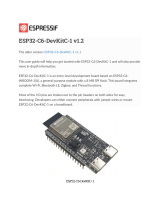
32UE has 38 pins. See pin definitions in Table
GND
1
P
Ground
EN
3
I
enable signal. Active high.
GPIO36, ADC1_CH0, RTC_GPIO0
GPIO39, ADC1_CH3, RTC_GPIO3
GPIO34, ADC1_CH6, RTC_GPIO4
GPIO35, ADC1_CH7, RTC_GPIO5
GPIO32, XTAL_32K_P (32.768 kHz crystal oscillator input), ADC1_CH4,
TOUCH9, RTC_GPIO9
SENSOR_VN 5
IO35
7
IO33
9
I/O
GPIO33, XTAL_32K_N (32.768 kHz crystal oscillator output),
ADC1_CH5, TOUCH8, RTC_GPIO8
GPIO25, DAC_1, ADC2_CH8, RTC_GPIO6, EMAC_RXD0
GPIO26, DAC_2, ADC2_CH9, RTC_GPIO7, EMAC_RXD1
GPIO27, ADC2_CH7, TOUCH7, RTC_GPIO17, EMAC_RX_DV
GPIO14, ADC2_CH6, TOUCH6, RTC_GPIO16, MTMS, HSPICLK,
HS2_CLK, SD_CLK, EMAC_TXD2
GPIO12, ADC2_CH5, TOUCH5, RTC_GPIO15, MTDI, HSPIQ,
HS2_DATA2, SD_DATA2, EMAC_TXD3
Ground
IO26
IO27
11
12
I/O
I/O
GND
IO13
15
16
P
GPIO13, ADC2_CH4, TOUCH4, RTC_GPIO14, MTCK, HSPID,
HS2_DATA3, SD_DATA3, EMAC_RX_ER
-
NC
NC
NC
NC
NC
18
19
20
21
22
-
-
-
-
GPIO15, ADC2_CH3, TOUCH3, MTDO, HSPICS0, RTC_GPIO13,
HS2_CMD, SD_CMD, EMAC_RXD3
GPIO2, ADC2_CH2, TOUCH2, RTC_GPIO12, HSPIWP, HS2_DATA0,
SD_DATA0
IO2
24
25
26
I/O
I/O
I/O
GPIO0, ADC2_CH1, TOUCH1, RTC_GPIO11, CLK_OUT1,
EMAC_TX_CLK
GPIO4, ADC2_CH0, TOUCH0, RTC_GPIO10, HSPIHD, HS2_DATA1,
SD_DATA1, EMAC_TX_ER
IO16
28
29
30
I/O
I/O
I/O
I/O
GPIO16,ADC2_CH8, TOUCH10
IO5
GPIO17,ADC2_CH9, TOUCH11
GPIO5, VSPICS0, HS1_DATA6, EMAC_RX_CLK
GPIO18, VSPICLK, HS1_DATA7
























